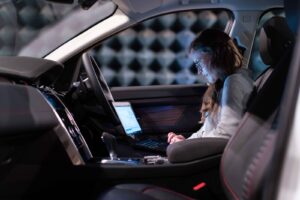In recent years, self-driving cars have emerged as a groundbreaking technology with the potential to revolutionize transportation as we know it. This article explores the concept of self-driving cars, their advantages, the underlying technology, the challenges they face, and the potential applications in various sectors.
Benefits of Self-Driving Cars:
Self-driving cars offer numerous benefits that can significantly impact society. They enhance safety on the roads by reducing human errors, improve mobility and accessibility for individuals who are unable to drive, optimize traffic flow, and contribute to a greener environment by reducing emissions.
 Technology Behind Self-Driving Cars:
Technology Behind Self-Driving Cars:
Self-driving cars rely on a combination of advanced technologies. Sensors and perception systems, such as radar, lidar, and cameras, provide the vehicle with a comprehensive understanding of its surroundings. Machine learning and artificial intelligence algorithms enable the car to interpret sensor data and make informed decisions. Mapping and localization technologies help the vehicle navigate accurately, while connectivity ensures communication with other vehicles and infrastructure.
Levels of Autonomy:
Self-driving cars are categorized into levels of autonomy defined by the Society of Automotive Engineers (SAE). These levels range from basic driver assistance to full automation, with each level progressively reducing the driver’s involvement.
Challenges and Concerns:
While self-driving cars hold immense potential, they also face several challenges. Legal and regulatory frameworks need to adapt to accommodate this technology, and ethical concerns must be addressed, particularly regarding decision-making algorithms. Cybersecurity risks and public acceptance also pose challenges that require attention.
Current and Future Applications:
Self-driving cars have already found applications in ride-hailing services and last-mile delivery. They are being explored for use in public transportation and personal ownership models. These applications offer increased convenience, efficiency, and reduced costs.
Implications for Urban Planning:
The introduction of self-driving cars will have profound implications for urban planning. With the rise of autonomous vehicles, the need for large parking lots and garages will diminish. Cities can repurpose these spaces for parks, green areas, or additional commercial and residential developments. This will lead to a more efficient use of urban land and a reduction in traffic congestion caused by drivers searching for parking.
Moreover, urban planners can reimagine city infrastructure and road design to optimize the flow of autonomous vehicles. Dedicated lanes or smart traffic management systems can be implemented to prioritize self-driving cars, ensuring smoother and safer transportation. Additionally, integrating self-driving cars with public transportation networks can lead to better connectivity and more sustainable urban mobility options.
The Road Ahead: Opportunities and Limitations:
The road to fully autonomous vehicles is still evolving. However, there are several key areas that need to be addressed to unlock their full potential. Continued advancements in technology, including the improvement of sensors, AI algorithms, and connectivity, will be crucial.
Collaboration between industry stakeholders, including automotive manufacturers, technology companies, policymakers, and researchers, is essential to drive innovation, establish standards, and develop interoperability among different self-driving car systems.
Policy and regulatory frameworks must also evolve to accommodate self-driving cars. Governments need to establish clear guidelines and regulations to ensure safety, address liability concerns, and define the roles and responsibilities of different stakeholders.
Addressing concerns through public awareness and education is vital for fostering acceptance of self-driving cars. People need to understand the capabilities, limitations, and benefits of autonomous vehicles to alleviate fears and build trust in this transformative technology.
Conclusion:
Self-driving cars have the potential to revolutionize transportation, offering numerous benefits in terms of safety, accessibility, efficiency, and environmental sustainability. The technology behind autonomous vehicles continues to advance, and their applications in various sectors, from ride-hailing services to public transportation, are expanding.
While challenges and concerns exist, including legal, ethical, and cybersecurity issues, these can be addressed through collaborative efforts and proactive regulation. As self-driving cars become more prevalent, urban planning will need to adapt to maximize their potential, creating smarter, more efficient cities.
With continued advancements, collaboration, and public awareness, self-driving cars are poised to shape the future of transportation, paving the way for a safer, more accessible, and sustainable world.








No Comment! Be the first one.